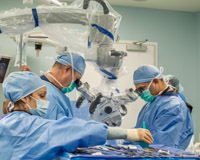One of the most effective procedures for chronic lower back pain is Anterior Lumbar Interbody Fusion (ALIF). This surgical technique involves accessing the spine through the abdomen to remove a damaged or degenerated intervertebral disc and replace it with a bone graft or implant. Over time, this promotes bone growth, ultimately fusing the adjacent vertebrae and stabilizing the spine. ALIF is unique in that it avoids cutting through back muscles, which can potentially lead to a faster recovery compared to other spinal fusion techniques.
Video: Meet Dr. Luke Macyszyn

Conservative Care Options Before Anterior Lumbar Interbody Fusion
Before considering Anterior Lumbar Interbody Fusion, non-surgical options such as the ones listed below are often explored:
- Physical therapy and core strengthening: Strengthening the muscles that support the spine can improve stability and reduce pain.
- Pain management techniques: Epidural steroid injections, nerve blocks, or radiofrequency ablation can help manage symptoms without surgery.
- Medications: Non-steroidal anti-inflammatory drugs (NSAIDs), muscle relaxants, and nerve pain medications can provide temporary relief.
- Minimally invasive procedures: Techniques like microdiscectomy or artificial disc replacement may be suitable alternatives for select patients.
- Progressive neurological symptoms, such as weakness or numbness in the legs
- Severe spinal deformities that impact posture and mobility
- Continued pain despite extensive non-surgical interventions

Anterior Lumbar Interbody Fusion Symptoms
Patients who benefit from ALIF often suffer from persistent lower back and leg pain, and neurological symptoms that interfere with daily life. Common conditions that may necessitate this procedure include:- Degenerative disc disease: A condition in which the intervertebral discs lose hydration and elasticity, leading to pain and instability.
- Spondylolisthesis: When one vertebra slips forward over another, causing instability and nerve compression.
- Spinal instability: This can occur due to trauma, congenital conditions, or degenerative changes that weaken the spine’s structure.
- Recurrent disc herniations: When a previously treated herniated disc reoccurs, causing persistent pain and dysfunction.
- Failed previous back surgeries: Patients who have not experienced relief from previous spine procedures may benefit from ALIF.
 "Anterior lumbar interbody fusion can be a game-changer for patients dealing with ongoing back and leg pain, especially if they’ve got issues like degenerative discs, slipped vertebrae, or even previous surgeries that didn’t quite do the trick. It’s all about stabilizing the spine and getting folks back to living their lives without constant pain holding them back."
"Anterior lumbar interbody fusion can be a game-changer for patients dealing with ongoing back and leg pain, especially if they’ve got issues like degenerative discs, slipped vertebrae, or even previous surgeries that didn’t quite do the trick. It’s all about stabilizing the spine and getting folks back to living their lives without constant pain holding them back."
Microscopic & Reconstructive Spine Surgeon

Anterior Lumbar Interbody Fusion Treatment Process
An Anterior Lumbar Interbody Fusion procedure requires collaboration between a spine surgeon and a vascular surgeon to safely access the lumbar spine. The surgery typically follows these steps:
- Preoperative Planning: A comprehensive evaluation including imaging, such as MRI, CT scans and X-rays, as well as a discussion of the patient’s medical history and symptoms.
- Surgical Approach: The spine is accessed through the front abdomen rather than the back, allowing for minimal disruption of the back muscles and ligaments.
- Disc Removal and Implant Placement: The damaged disc is then removed, and an implant filled with bone graft material is inserted into the space to restore disc height and relieve nerve compression.
- Fusion Process: Over time, the implant encourages new bone growth, effectively fusing the adjacent vertebrae into a single solid structure.
- Postoperative Stabilization: In some cases, additional posterior hardware such as screws and rods may be needed to support fusion and enhance stability.
 "ALIF is a team effort—it takes a spine surgeon and a vascular surgeon working together to safely get to the lumbar spine through the front of the abdomen, which is easier on the back muscles. A lot of my patients are sometimes surprised to hear that the surgery can take just a couple hours or so. But bottomline, it's a surgery we have a lot of success with at DISC in terms of treating patients' pain or immobility."
"ALIF is a team effort—it takes a spine surgeon and a vascular surgeon working together to safely get to the lumbar spine through the front of the abdomen, which is easier on the back muscles. A lot of my patients are sometimes surprised to hear that the surgery can take just a couple hours or so. But bottomline, it's a surgery we have a lot of success with at DISC in terms of treating patients' pain or immobility."
Neurological Spine Surgeon

Anterior Lumbar Interbody Fusion Recovery and Rehabilitation
Recovery from a Anterior Lumbar Interbody Fusion typically involves:
- A Short Hospital Stay: If the surgery is conducted at an inpatient setting, most patients will stay in the hospital for one to three days, depending on the complexity of the procedure and individual healing rates. However, if a patient has their ALIF surgery at an ambulatory surgery center (like DISC), patients will spend a few hours recoverying and mobilizing at the ASC.
- Pain Management: Patients are given a combination of medications to control pain and reduce inflammation after the surgery.
- Movement Restrictions: Bending, lifting and twisting should be avoided in the early weeks of recovery to allow the fusion process to begin successfully.
- Physical Therapy: A structured rehabilitation program begins within a few weeks, focusing on core strengthening, flexibility and gradual activity resumption as the patient recovers.
- Fusion Completion: Bone fusion can take six to 12 months, during which follow-up appointments and imaging tests ensure proper healing and integration of the implant.
Many patients experience significant pain relief and improved mobility after recovering from an Anterior Lumbar Interbody Fusion. While activity levels must be gradually restored, most individuals return to an active lifestyle, including work, exercise and their hobbies. While an Anterior Lumbar Interbody Fusion allows many individuals to resume normal activities, some adjustments may be necessary:
- High-impact activities: Running and heavy lifting should be approached with caution to prevent undue stress on the fused segment.
- Weight management: Maintaining a healthy weight reduces strain on the spine and promotes long-term fusion success.
- Posture awareness: Proper sitting and standing posture play a crucial role in preventing adjacent segment degeneration.
To ensure long term success, patients should adhere to post-operative guidelines and maintain spine health through proper ergonomics and strengthening exercises.
Anterior Lumbar Interbody Fusion is a valuable procedure for those suffering from severe spinal conditions that have not responded to conservative treatments. It offers a well-proven solution for spinal stability and pain relief, with many patients experiencing a renewed ability to engage in everyday activities.
If you’re experiencing persistent back pain and conservative treatments haven’t relieved the pain, it may be time to consider surgery. Set up a consultation with a spine specialist at DISC to help determine the best path forward for your long-term health and well-being.

About the author
discmdgroup DISC Sports & Spine Center (DISC) is a national leader in minimally invasive spine surgery, orthopedic surgery, and sports medicine care. Our spine surgeons set the standard in artificial disc replacement, spine fusion, discectomy, microdiscectomy and the full spectrum of spine procedures. The group’s orthopedic surgeons advance the state of joint preservation surgery and total joint replacement, including total knee replacement as well as total hip replacement. Our flagship surgery centers based in Newport Beach, Marina del Rey, and Carlsbad serve patients local to Los Angeles, Orange County and San Diego, as well as the rest of the country. Read more articles by discmdgroup.





